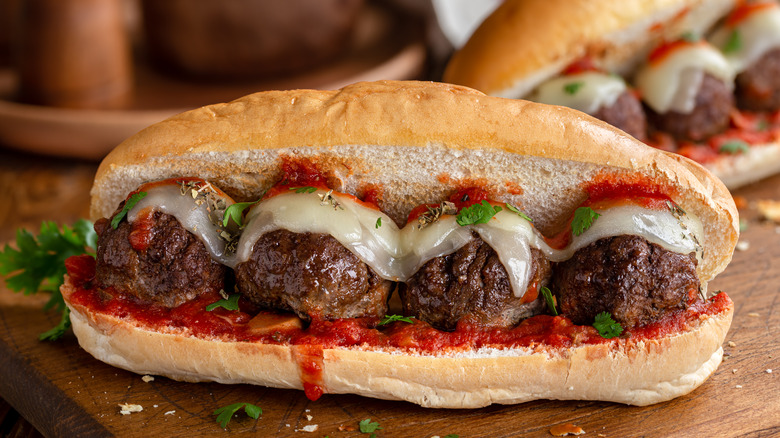The Unexpected Ingredients That Will Add Flavor And Texture To Your Next Meatball Meal
You usually find them covering your plate of spaghetti, or you may locate them between two hoagie rolls smothered in marinara sauce and Mozzarella cheese. However, one thing is for sure, almost every fan of meat-centric dishes enjoys a delicious meatball.
Although the origins of meatballs have been up for debate (via Auguste Escoffier School of Culinary Arts), many believe they came from Persia before the dish made its way into Italy, where they are most commonly associated today. As such, it may not surprise you that the spherical dish has included various ingredients across cultures and borders. Smithsonian Magazine explains that Italian meatballs and American meatballs — or the kind we're used to seeing on our spaghetti or sandwiches — are a bit different. American-style versions are much denser and meatier than the Italian "polpettes," which were smaller and usually made of varying types of meat depending on what region of Italy they were made in.
Like many other foods, the meatball has evolved over time, changing from generation to generation. So your grandmother's recipe may not be the same as your friend's grandmother's recipe, or even your preferred recipe, for that matter. In the spirit of this beloved dish constantly changing as it rolls its meaty way across the globe, we're celebrating a couple of surprising ingredients to add some welcome flavor and texture to your next recipe.
Should you add yogurt to your meatballs?
Pistachios? Yogurt? In my meatballs? This sounds like some kind of joke, right? However, while a cup of yogurt doesn't sound like it translates all that well into a savory meat dish at first glance, looks can be deceiving, and this may be an ingenious trick to getting a much more tender dish.
TODAY details a recipe for pork and pistachio meatballs, which has the reader first prepare a "hydrated panko mixture" out of Greek yogurt, egg, and panko breadcrumbs. This mixture acts as the binding agent for the ground pork, thus letting you form meatballs. Even Martha Stewart's website offers a recipe that includes a yogurt sauce, claiming that "yogurt turns surprisingly velvety when cooked with cornstarch and egg yolks." So what exactly makes Greek yogurt a good choice in meaty dishes?
According to Taste Cooking, Greek yogurt helps to make the meat much moister and gives the meat a delicious crust as it caramelizes in the oven. The thick texture of the yogurt also allows seasonings to adhere better to the meat, such as spices in a meatball, while the gentle acidity of the yogurt helps to provide a much more forgiving marinade. Additionally, this technique is no flash in the pan: the practice can be dated back to the regions of Central Asia in the thirteenth or fourteenth centuries.
You can also add ricotta cheese for extra moisture
Let's say you're still a bit wary of adding yogurt to your meatball mixture, but you like the idea of achieving a moister consistency. Fortunately, another dairy product will help you achieve a moist and flavorful result — and may be a bit more familiar to you if you like lasagna.
Chef John, via his blog Food Wishes, details his recipe for what he calls "experimental meatballs." What made these experimental was the addition of ricotta cheese, which Chef John feared would make them tough due to the extra mixing required. The end product, however, turned out to have a delicious texture, alongside solving the problem of "overmixing" the meat. NYT Cooking also offers a recipe for ricotta and pork meatballs, describing the ricotta as the "secret to tenderness" in the meat.
Even big-name chefs like Michael Symon and Giada De Laurentiis use ricotta in their meatballs. However, De Laurentiis uses a bit of cinnamon in her recipe for extra warmth and a subtle flavor. While you can still add whatever other cheeses you like, such as a grated Parmesan coating, adding a spoonful or two of ricotta will help prevent any toughness or chewiness from ruining your spaghetti or sandwich.


